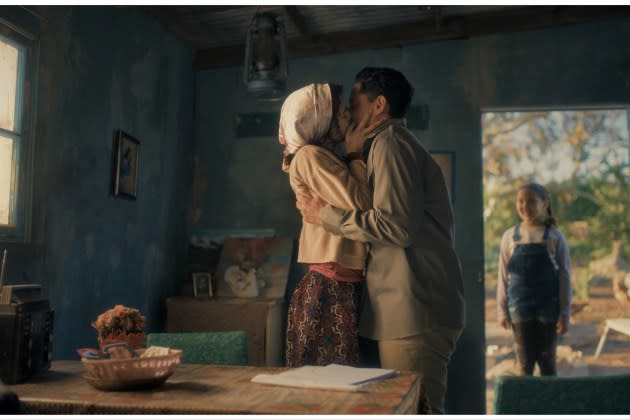Rural Community Thriller ‘Snake’ Shows How Streamer Support Makes Smaller South African Stories Possible

South African rural community thriller “Snake,” the closing film of the 6th Joburg Film Festival, is a feature that wouldn’t have been made if it wasn’t for streamer money.
Based on the heart-wrenching 2011 book by Tracey Farren, who also penned the screenplay, a powerless farm girl Stella, played by 9-year-old Lamiyah Barnard, becomes the only one who can stop a smarmy and mysterious interloper who arrives with a flute and dazzles everyone in a rural town, hiding his nefarious intent while going on a killing spree.
More from Variety
“Snake” will play on two streamers and was made with pre-license funding from both: eMedia and e.tv’s eVOD in South Africa and Amazon’s Prime Video.
Shot in rural South Africa with painfully beautiful scenes of poverty and decay, the Known Associates Entertainment production was lensed over seven and a half weeks near Atlantis, Malmesbury and Philadelphia in the Western Cape province.
Director Meg Rickards of Boondogle Films tells Variety the story “has been on my radar for a long time.” “Farren also wrote ‘Tess,’ which was another film I made for kykNET, so I knew Tracey well by now. ‘Snake’ started off its life as a screenplay. Tracey wrote it in 2009 — she is a trained screenwriter. Then she wrote the novel and then she came back to the screenplay — so it’s a very unusual version. It meant that the novel was obviously ripe for being a film because it was originally conceived as a film.”
Audiences might gasp at an attempted drowning scene toward the end of the film that Rickards explains “was actually very difficult because Lamiyah couldn’t swim.”
“We gave her swimming lessons and she was doing really, really well. But on the day at the pool she really panicked so we couldn’t work for very long. In fact, we did use a double at the dam scene. That was the hardest thing she had to do. Lamiyah also learnt to play the penny whistle from scratch. When you see her play that’s not sound replacement.”
The film is a riveting story on a small canvas, confronting big issues.
“‘Snake’ was shot very micro because it was about Stella’s perspective. In the end, we really felt we needed to feel the land in a bigger way so we did the aerial drone shots a month into post. You get the contrast between the drone shots for context but you also see flowers and feathers and eggs because the story is told from Stella’s point of view,” Rickards explains.
“We didn’t use any special technology as we tried to film it very much from Stella’s point-of-view to focalize the viewer experience through the 9-year-old’s eyes. We often have the camera in Stella’s shoes. I didn’t want to film this with big tricks and expensive stuff. I also didn’t want to patronize the child’s point of view. It’s locked to her point of view and that’s how we use the camera.”
Rickards says filming of “Snake” was unusual due to “a gentleness on set that’s very rare.”
“On the first day I addressed the crew and said, ‘Look, we have to approach this in a different way. We can’t shout, we can’t swear, we can’t have the kind of bullish energy that often permeates sets.’ We also chose our crew very carefully — people we felt would be gentle and calm. Because of that, there was a beautiful, gentle energy because sets can be very hectic places. We didn’t want the child to feel uncomfortable, we didn’t want her to feel that she was coming into this adult space. It was a very tricky story to tell but everyone understood that and created a safe space.”
“‘Snake’ is also about the depiction of very poor people not often shown in mainstream media. They’re not considered interesting enough or glamorous enough. We don’t like to turn the lens on them. Docs do but fiction films don’t often,” she says.
“I wanted to put a poor community center stage and shine the light on them — not in a didactic way but just to say: ‘This is how people are living.’ It’s not meant to be social realism at all — that’s also what makes it palatable. But I wanted to tell a story that put very poor, disenfranchised and dispossessed people front and center and I just love the tale.”
Rickards says the influx of streamer money to South Africa’s growing film biz “broadens the scope because they’re not going for big blockbusters and the budgets aren’t for that.”
“I do think it democratizes the field and allows more people to tell stories. From that point of view, streaming is exciting — it allows you to tell smaller stories.”
“There’s a realization that we can’t compete with Hollywood. In the past South African films often tried to emulate Hollywood and always ended up looking like its poor cousins. We can’t compete in that space. It’s better to do something that’s a universal story.”
“‘Snake’ can have universal appeal as a little girl’s journey — but we’re making it for a local audience.”
Best of Variety
Sign up for Variety’s Newsletter. For the latest news, follow us on Facebook, Twitter, and Instagram.
